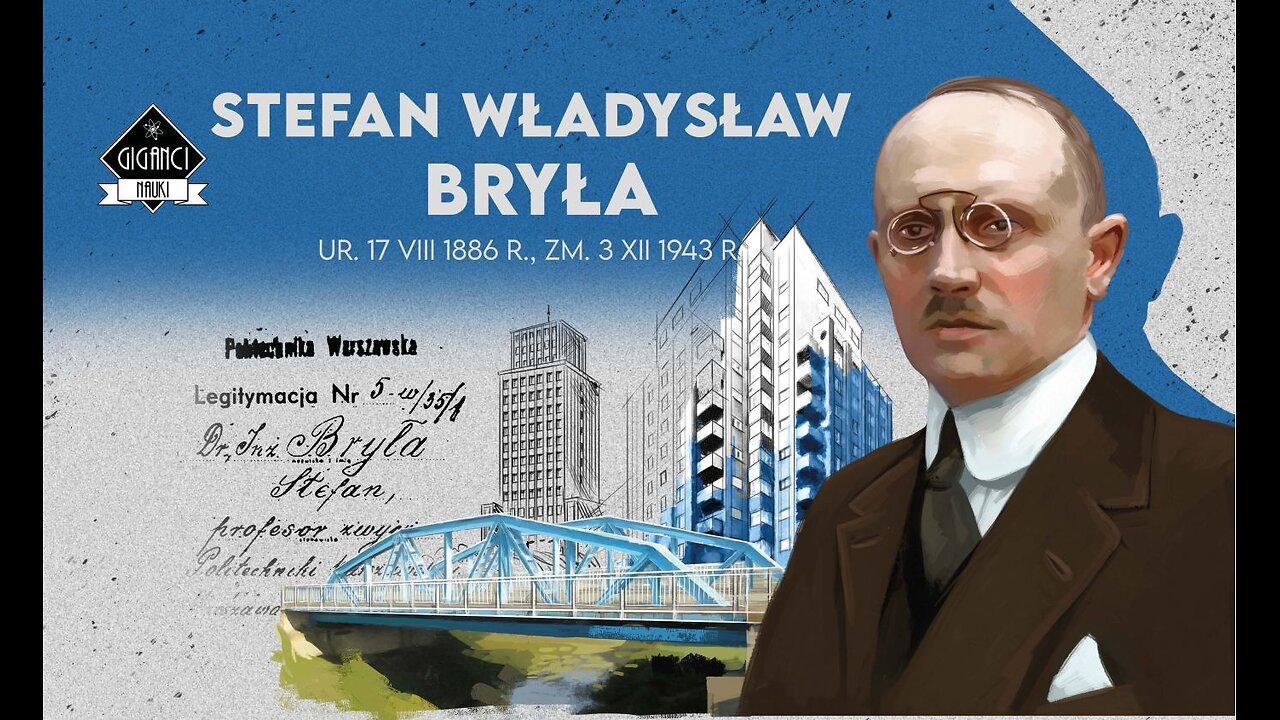Premium Only Content

Polish Genius : Dr Stefan Bryla
Giants of Science – Historical Infographics: Stefan Bryła
The Institute of National Remembrance recalls how Polish inventors and scientists changed the world and how much they contributed to the development of our country and other countries. BRYŁA Stefan Władysław (17 August 1886, Kraków – 3 December 1943, Warsaw), construction engineer, innovator, pioneer in the global application of welding in construction. Son of Paweł, a high school teacher, Polish teacher, and Eligia née Chrzanowska, a social activist and publicist.
In 1903 he graduated with distinction from the real school in Stanisławów and entered the engineering department of the Polytechnic School in Lviv. In 1908 he obtained a diploma with distinction. Already during his studies, from 1907 he was an assistant at this school, in 1909 he defended his doctorate in technical sciences, from June 1910 he taught technical drawing and the encyclopedia of engineering sciences as a private lecturer, and from July of that year he taught structural engineering as a full-time lecturer.
Sent by the Kraków University of Applied Sciences in the autumn of 1910 for supplementary studies, he deepened his knowledge at the Königliche Technische Hochschule in Berlin-Charlottenburg, the École des Ponts et Chaussées in Paris and at the University of London, while also practicing engineering in the field of steel structures. In 1912 he stayed in Canada and the USA, participating in large construction projects, including the construction of the Woolworth Building in New York, then the tallest building in the world (250 m). On his way back he visited Chicago, Detroit, the Yellowstone National Park, California, Hawaii, Japan, Korea, northern China and Manchuria, from where he reached Poland by train through Siberia. In 1913 he started working at the university in Lviv. During the 1914 vacation, he went on a honeymoon to Turkey, Persia, the Caucasus, and Armenia. It was interrupted by the outbreak of World War I. As an Austro-Hungarian subject, he was interned with his wife in Tiflis (now Tbilisi) in Georgia, and then in Kiev, where B. worked in a bridge office (1915–18), lectured on general construction at the Polish University College (until 1917), and was active in Polish organizations, including as president of the Association of Polish Engineers and Technicians in Russia (he was vice-president of the Congress of Polish Technicians in Russia, which took place in Moscow in 1917).
In the spring of 1918 he returned to Poland, in November of that year he took part in the defense of Lwów (he was awarded the Cross of Valor), in 1919 he began working at the Ministry of Public Works in Warsaw, soon as head of the bridge department. In 1920 he fought as a volunteer in the Polish-Bolshevik war.
In 1921 B. was appointed full professor at the Lviv Polytechnic and took over the management of the 2nd Department of Bridge Construction. He significantly expanded the lecture program, including in the field of spatial trusses, reinforced concrete, and eventually welding of steel structures. He introduced the concept of spatial influence surface to the theory of bridges. In 1923 he was in the USA again to familiarize himself with the state of standardization in American construction. During the return journey by ship he fell ill with severe arthritis, which resulted in several surgical operations and a permanent shortening of one leg.
Since 1932, B. was a member of the ANT in Warsaw. Appointed on 18 October 1934 to the Department of Structural Engineering at the Faculty of Architecture of the Warsaw University of Technology, he organized the Building Research Institute, where laboratory tests were conducted in the field of soil mechanics, building acoustics and fire resistance of building materials, using, among others, X-ray technology. In 1938, he was elected dean. B. was also actively involved in engineering practice. He designed several important structures. A supranational achievement was the first welded steel road bridge in Europe over the Słudwia River in Maurzyce near Łowicz with a span of 27 m, put into service on 12 August 1929. In 1928, B. developed regulations for the Ministry of Public Works regarding the use of welding in construction, which over time became a model for other countries. He also designed the welded structure of the Prudential Insurance Company skyscraper at Napoleon Square in Warsaw (1932), at that time the tallest (66 m) building in the capital (currently the Hotel Warszawa at Powstańców Warszawy Square). The skeleton of this building turned out to be exceptionally strong, it did not collapse despite being hit by over a hundred artillery shells during the Warsaw Uprising in 1944. B. was also the author of the designs of, among others, reinforced concrete structures of the steam locomotive factory hall, the student dormitory at Narutowicza Square and the building of the General Mutual Insurance Company at Kopernika Street in Warsaw, the welded structure of the Jagiellonian Library building in Kraków (he used hollow steel columns in it), the Market Hall in Katowice (with welded girders with a span of 39.5 m), several military buildings in Warsaw, including the building of the current Air Force and Air Defence Command at Żwirki i Wigury Street.
He published widely, taking care of the usefulness of modern scientific findings in engineering practice. He was the initiator, main editor and author of seven chapters of the four-volume Engineering Manual (1927–32) – the first Polish encyclopedia in the field of construction, as well as many manuals and articles, also in foreign professional journals. In total, he published over 250 scientific works. He also took an active part in political life. He was elected to the Polish Sejm three times from the Christian Democratic list in the Sambor district, from 1934 he was the president of the Main Council of the Christian Trade Union, and in 1935 he became the president of the Christian Workers' Association. In 1926 he participated in the parliamentary delegation examining in Tunis, Algiers and Morocco the possibilities of settling Polish emigrants in French African possessions. He was also a co-founder of the Polish Association of Construction Engineers (May 1934).
During the German occupation, B. actively participated in underground polytechnic education, also lecturing from 1942 at the official State Higher Technical School. He also held important positions in the structures of the Polish Underground State, directing technical and industrial intelligence and planning the post-war reconstruction of Poland and the directions of its future development. Together with engineer W. Gokieli, he developed a ten-year plan for such reconstruction.
Arrested on November 10, 1942, ransomed from Pawiak after a month, he did not cease his conspiratorial activities. Arrested again with his entire family on November 16, 1943, he was shot on December 3 of that year with a group of hostages near the tram depot on Puławska Street in Warsaw.
B. is named after one of the streets in Warsaw's Mokotów district, and since 1994 - the auditorium in the building of the Faculty of Architecture of the Warsaw University of Technology at the corner of Koszykowa and Lwowska streets, as well as school complexes in Warsaw and Białystok. Since 1964, the Polish Union of Construction Engineers and Technicians has awarded the Stefan Bryła Prize for scientific and research or scientific and technical achievements in the field of building structures. SBTP (T. Skarzynski); SPPT (B. Orłowski); Łoza; Srodka.
-
 8:40
8:40
The Lou Holtz Show
17 hours agoLou Holtz Slams Open Borders: "Do the Right Thing—Keep Americans Safe!
1.56K4 -
![[Ep 630] Election Integrity w/ Guest Steve Stern! | Sam Anthony [your]NEWS | Laura Loomer Delivers!](https://1a-1791.com/video/fww1/23/s8/1/G/S/8/t/GS8ty.0kob-small-Ep-630-Election-Integrity-w.jpg) 3:04:33
3:04:33
The Nunn Report - w/ Dan Nunn
16 hours ago[Ep 630] Election Integrity w/ Guest Steve Stern! | Sam Anthony [your]NEWS | Laura Loomer Delivers!
3.29K10 -
 11:33
11:33
Russell Brand
18 hours agoThe Democratic Party is Becoming A Parody
102K258 -
 26:17
26:17
The Brett Cooper Show
1 day agoWhy Trans Activists Are Attacking This Gym Owner | Episode 14
85.6K81 -
 42:04
42:04
Film Threat
20 hours agoSNOW WHITE EARLY REACTIONS! | Film Threat After Dark
51.8K11 -
 2:57:45
2:57:45
GoodLawgic
9 hours agoThe Following Program: Day 57 Recap: JF Files Realeased; Russo-Ukrainian Cease Fire?
30.9K10 -
 2:42:22
2:42:22
Badlands Media
1 day agoEye of the Storm Ep. 240
120K40 -
 8:15:45
8:15:45
MyronGainesX
1 day ago $40.74 earnedJFK Files Exposed With Cory Hughes! Israel Ends Ceasefire!
107K21 -
 1:19:34
1:19:34
Awaken With JP
18 hours agoJFK Files FINALLY Released - LIES Ep 83
108K98 -
 22:41
22:41
Stephen Gardner
11 hours ago🔥I Can't BELIEVE What JUST HAPPENED to Trump!
73.7K182